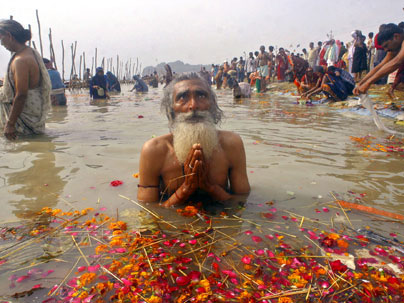Not too many people in America would find it particularly striking to walk into a grocery store and find fifteen different types of cereals, all fresh and tightly packaged. Nor would we consider it rather unusual that there is an entire aisle dedicated to cold milk to accompany it. But in many other countries, this is not the norm. For example, Sarah F. studying at Kansai Gaidai University says: "Everything food-wise in America is huge in comparison to Japan! Drink and package sizes, etc. are so much smaller [here], except for bowls of noodles."
Our supersized portions have taken a toll on our health: among the top five leading causes of death in America are heart disease, cancer, stroke, and diabetes - all related to obesity.
I can barely make a - pot? pan? - of spaghetti, but my aunt - who works in the food industry - persuaded me to go with her to Jackson Heights, New York to learn about Ayurveda (using food as a medicine) with a group from the Institute of Culinary Education. I knew that all the money raised goes toward a good cause (educating widowed child brides in India), but I was still suspicious.
I used to have some pretty bizarre notions about people who practice ayurvedic 'medicine' - I envisioned a group of hippies smoking pipes, singing, dancing, and just generally swept up in a blind mockery of Indian values and spirit, the way most Indian culture is interpreted in the west. I envisioned a cult-like scene like 'Dum Maro Dum' from 'Hare Rama Hare Krishna' (Dev Anand, 1971). But then again, I manage to make pancake batter into rocks, so what do I know?
Mr. Subrato Bhattacharya, travel consultant, photographer, and food stylist for the United Nations (quite a job description, eh?) was our foodie guru and lent some insight into the difference between Indian and American diets.
"Ayurveda is an ancient Indian science and art," Bhattacharya explained. "The word 'ayurveda' literally means 'body knowledge'."
Ayurveda uses food as a medicine to enhance energy, improve complexion, clear the senses, strengthen vocal power, add longevity, lighten mood, nurture the spirit and increase physical stamina.
"You are what you eat. Our body and the earth are made up of the same components. Put simply, the body is just a byproduct of food," he clipped.
There are two concepts of cooking in ayurveda: consuming a balanced combination of earth elements to create a balanced chemical reaction from the body. Our American diet generally promotes negative imbalance. For example, dipping chicken nuggets in honey mustard sauce may cause loss of vision, trembling, and lowered IQ. Drinking milk with fruit may cause acidity and stomach upset.
Why is this?
"Every person is born with a certain balance of
wata, pita and
kapha in their bodies," says Bhattacharya. "
Wata - meaning air,
pita - meaning energy, and
kapha - propensity to illness."
Different foods can alter the balance of
wata, pita and
kapha. Beans, for example, are a
wata-pita food. Milk and dairy are
kapha foods. Fresh meat, fruit, and vegetables - once living elements of nature - are energizing,
pita foods and provide much more nutrition than processed foods.
"Please, I beg you, do
not eat processed foods," Bhattacharya pleaded. "They do no good. You will become very vulnerable to sickness and disease."
Most American foods are high in fat and calories, but low in nutritional value. We eat irregularly, at odd hours, and in huge quantities. It is difficult to break the cycle that is so grounded in the culture. We skip breakfast, snack through lunch, and then finally eat a big meal right before bed. We are too isolated and busy to care. There just isn't any specific time that we can call meal-time.
But is the pot calling the kettle black? Perhaps feeling too overwhelmed to eat properly is just a symptom of inefficient nutrition.
You don't have to learn Indian cooking to learn the lessons of ayurveda. Just listen to your body and be sensible about its needs. Don't try to assess your dietary needs with numbers on a scale - think about your emotions. Feeling a little down? Perhaps some
pita foods, like a salad or turkey sandwich will help. Mad at the world today? Try some yogurt or cheese. Hopefully with practice, discipline, and time, we will come to appreciate our bodies for what they are - moving structures of
energy - and the 'battle against the bulge' will end.
 मैं उसकी माँ एक बच्चे के रूप में आपके पास आया,
मैं उसकी माँ एक बच्चे के रूप में आपके पास आया, 
 I thought that it would perhaps be interesting to start a series of posts on conversational Hindi. There are a few sites on the internet that teach Hindi vocabulary, but seem to overlook the wonderfully unique way of phrasing things that Indians have. You can study Hindi grammar and vocabulary for days, months, even years - but never be understood by native speakers, only because you cannot literally translate English sayings into Hindi sayings.
I thought that it would perhaps be interesting to start a series of posts on conversational Hindi. There are a few sites on the internet that teach Hindi vocabulary, but seem to overlook the wonderfully unique way of phrasing things that Indians have. You can study Hindi grammar and vocabulary for days, months, even years - but never be understood by native speakers, only because you cannot literally translate English sayings into Hindi sayings.